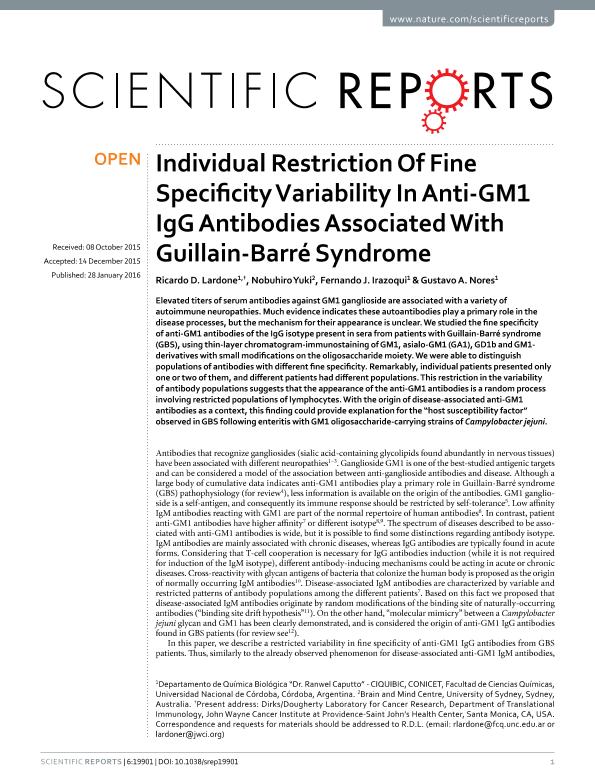Artículo
Individual restriction of fine specificity variability in anti-GM1 IgG antibodies associated with Guillain-Barré Syndrome
Fecha de publicación:
01/2016
Editorial:
Nature Publishing Group
Revista:
Scientific Reports
ISSN:
2045-2322
e-ISSN:
2045-2322
Idioma:
Inglés
Tipo de recurso:
Artículo publicado
Clasificación temática:
Resumen
Elevated titers of serum antibodies against GM1 ganglioside are associated with a variety of autoimmune neuropathies. Much evidence indicates these autoantibodies play a primary role in the disease processes, but the mechanism for their appearance is unclear. We studied the fine specificity of anti-GM1 antibodies of the IgG isotype present in sera from patients with Guillain-Barré syndrome (GBS), using thin-layer chromatogram-immunostaining of GM1, asialo-GM1 (GA1), GD1b and GM1-derivatives with small modifications on the oligosaccharide moiety. We were able to distinguish populations of antibodies with different fine specificity. Remarkably, individual patients presented only one or two of them, and different patients had different populations. This restriction in the variability of antibody populations suggests that the appearance of the anti-GM1 antibodies is a random process involving restricted populations of lymphocytes. With the origin of disease-associated anti-GM1 antibodies as a context, this finding could provide explanation for the "host susceptibility factor" observed in GBS following enteritis with GM1 oligosaccharide-carrying strains of Campylobacter jejuni.
Palabras clave:
Anti-Gm1 Antibodies
,
Fine Specificity
,
Guillain-Barre Syndrome
Archivos asociados
Licencia
Identificadores
Colecciones
Articulos(CIQUIBIC)
Articulos de CENTRO DE INVEST.EN QCA.BIOL.DE CORDOBA (P)
Articulos de CENTRO DE INVEST.EN QCA.BIOL.DE CORDOBA (P)
Citación
Lardone, Ricardo Dante; Yuki, Nobuhiro; Irazoqui, Fernando Jose; Nores, Gustavo Alejandro; Individual restriction of fine specificity variability in anti-GM1 IgG antibodies associated with Guillain-Barré Syndrome; Nature Publishing Group; Scientific Reports; 6; 1-2016
Compartir
Altmétricas




